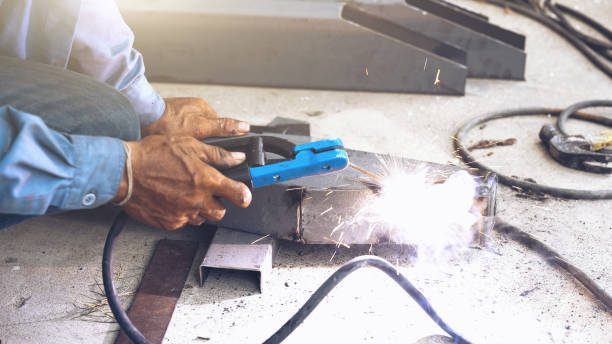
| Tool and Die Maker Key Stats | |
|---|---|
| Education | 1-2 Years |
| Job Outlook | 6% |
Tool and Die Makers are highly skilled professionals who work in the manufacturing industry.
Their work makes it possible to construct and maintain machines that are used to create several kinds of products we use on a daily basis.
Tool and Die Makers are some of the most highly trained professionals working in the manufacturing industry.
These professionals make and repair the tools, dies and devices that are used to create products such as clothing, furniture and aircraft parts.
Tool and Die Makers can work in manufacturing firms that create the tools themselves or shops that focus on producing tools for other manufacturing firms.
These professionals may work in hazardous environments and need to use safety precautions in order to perform their daily functions.
Table of Contents
Education Requirements to Become a Tool and Die Maker
Candidates who want to become a Tool and Die Maker will need four or five years of working in this trade in order to become fully trained and prepared to work independently in the field.
Candidates can learn the skills necessary to become a Tool and Die Maker by attending a formal education program, post-secondary program or through an apprenticeship.
In order for candidates to be accepted into an apprenticeship or post-secondary program, they must have a high school diploma or its equivalency, a background in physics or mathematics such as geometry and trigonometry.
In addition, employers seek candidates with strong problem solving skills and the ability to use computer programs and software.
The majority of employers seek candidates who have completed an apprenticeship program.
During an apprenticeship, students will learn how to perform basic functions by hands on work as well as through a variety of classroom hours.
An apprenticeship may take up to four or five years to complete.
Applicants who finish an apprenticeship through a state or company funded program are required to complete a series of test showing their competency in the field.
Certification for this profession is not required although many employers prefer hiring candidates with this trait.
Candidates who seek certification will need to have a high school diploma or its equivalent, completed several mathematics courses and be at least 18 years of age.
Tool and Die Maker Job Description
In order to design and create tools and dies, these professionals must have the ability to use computer aided design (CAD).
Tool and Die Makers use CAD in order to create blueprints and plans for the variety of tools and dies they are responsible for creating.
Tool Makers need the ability to read and use blueprints in order to begin making a variety of tools.
A Tool and Die Maker’s goal is to produce precision tools that are used for a variety of functions such as cutting, shaping and forming materials such as metal.
In addition to creating tools, Tool Makers are also responsible for making jigs, fixtures, gauges and other measuring tools.
Die Makers are specifically responsible for creating a variety of metal forms referred to as “dies.” These metal forms are used for forging and stamping functions.
These professionals also create metal molds that are then used to create a variety of plastic, ceramic and composite products.
Tool and Die Maker Salary and Career Path
The Bureau of Labor Statistics reports that the median wage for Tool and Die Makers in 2008 was approximately $22.32 per hour.
The salary range for these professionals during the same year was approximately $14.69 to $34.76 per hour.
Exact hourly wage will depend on a Tool and Die Maker’s experience, geographical location and the industry they work in.
Professionals working in the motor vehicle parts manufacturing industry earn, on average, more.
The median wage for professionals working in this sector is approximately $27.99 per hour.
The employment outlook for Tool and Die Makers is expected to decrease through the year 2018.
Job opportunities are expected to decrease by approximately 8 percent through 2018.
This decline will be due to foreign competition, advanced technology and machinery as well as increased worker productivity.
Advances in technology include improved automation, the use of CNC machine tools and manufacturing equipment designed to perform automatically.
Even with a decline of 8 percent, an applicant who wants to become a Tool and Die Maker should expect to find plenty of job opportunities in this trade.
The Bureau of Labor Statistics also reports that employers have a hard time finding candidates who are qualified to perform this trade’s basic functions.
![]() The below information is based on the 2023 BLS national averages.
The below information is based on the 2023 BLS national averages.
National Average Salary
$62,020Average Salary by State
| State | Avg. Annual Salary |
|---|---|
| Alabama | $60,110 |
| Arizona | $64,070 |
| Arkansas | $48,390 |
| California | $69,570 |
| Colorado | $58,940 |
| Connecticut | $71,360 |
| Florida | $59,820 |
| Georgia | $57,550 |
| Idaho | $56,940 |
| Illinois | $59,930 |
| Indiana | $62,550 |
| Iowa | $58,860 |
| Kansas | $65,210 |
| Kentucky | $62,190 |
| Louisiana | $56,890 |
| Maine | $72,290 |
| Maryland | $61,410 |
| Massachusetts | $67,700 |
| Michigan | $63,500 |
| Minnesota | $62,380 |
| Mississippi | $52,450 |
| Missouri | $57,850 |
| Nebraska | $60,510 |
| Nevada | $67,420 |
| New Hampshire | $68,850 |
| New Jersey | $65,920 |
| New York | $65,640 |
| North Carolina | $58,910 |
| North Dakota | $63,620 |
| Ohio | $60,950 |
| Oklahoma | $63,370 |
| Oregon | $74,710 |
| Pennsylvania | $58,550 |
| Rhode Island | $62,320 |
| South Carolina | $64,260 |
| South Dakota | $53,150 |
| Tennessee | $55,890 |
| Texas | $59,140 |
| Utah | $60,590 |
| Vermont | $69,950 |
| Virginia | $51,830 |
| Washington | $78,290 |
| Wisconsin | $61,310 |
| Puerto Rico | $36,370 |
The top earning state in the field is Washington, where the average salary is $78,290.
These are the top 5 highest-paying states in the field:
* Employment conditions in your area may vary.
Frequently Asked Questions
What does a tool and die maker do?
Tool and die makers make and repair dies, tools, fixtures, and gauges.
They also make metal molds that are used for die casting and for molding ceramics, plastics, and other materials.
Because the metals parts and instruments they produce require a lot of precision, tool and die makers use computer-controlled (CNC) and mechanically controlled machine tools.
Their work consists of reading blueprints, sketches, CAD files or similar specifications, entering designs into computer programs that produce blueprints, setting up machine tools, testing the final products and smooth and polish the tools and dies produced after this process.
Tool and die makers are trained not only to operate a CNC machine but also to write CNC programs.
What is the annual wage of tool and die makers?
According to the Bureau of Labor Statistics, the median annual wage for tool and die makers was $52,750 as of May 2018.
Salaries vary depending on the industry; those who worked for the metalworking machinery manufacturing earned a median wage of $49,740 a year, while those who are employed in the aerospace product and parts manufacturing field earned a median wage of $74,740 a year.
There are many other factors that may influence a tool and die maker’s salary and they can earn anywhere between less than $33,000 and more than $75,000 a year.
How much does it cost to become a tool and die maker?
Tool and die makers typically need to complete a post-secondary program or apprenticeship.
Many vocational schools, technical schools, and community colleges offer programs that teach students design, how to read blueprints, how to use welding and cutting tools and how to program and operate CNC machine tools.
CNC training programs can cost anywhere between less than $5,000 and more than $15,000 depending on the program you choose.
Apprenticeship programs are also available and these programs combine hands-on on-the-job paid training with technical classroom study.
Some colleges and organizations also offer certification programs such as the Skills Certification System.
What is the demand for tool and die makers?
According to the Bureau of Labor Statistics, the demand for tool and die makers is projected to decline 6 percent from 2018 to 2028.
This decline is caused, in part, by the fact that technological advances will reduce the number of tool and die makers that will be needed to program and operate CNC machine tools.
How long does it take to become a tool and die maker?
Training programs for tool and die makers are available at some community colleges and technical schools and can typically be completed in around 2 years.
Tools and die makers can also learn this trade through 4-5 years of apprenticeship training.
Apprenticeship programs are typically sponsored by a local manufacturer and consist of paid on-the-job training and technical instruction.













